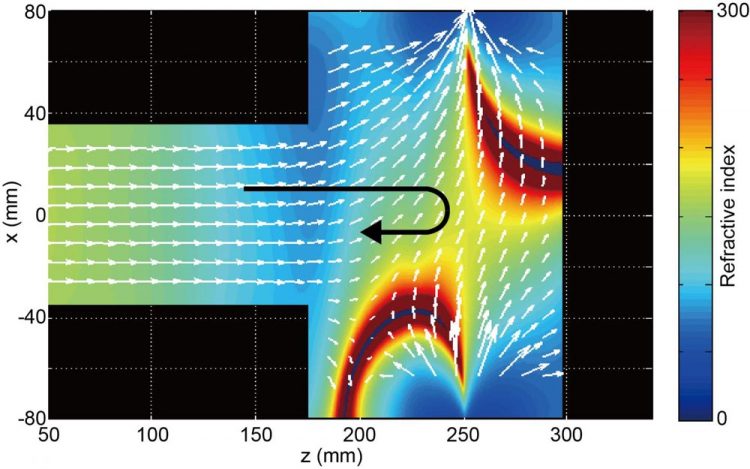New plasma source favorable for hydrogen negative ion beam is developed

Two-dimensional profiles of the magnetic field vector (white arrows) and the axial refractive index (contour plot). The bold black arrow indicates the reflection of the wave by the rapidly bent magnetic field. Credit: Kazunori Takahashi
Led by Associate Prof K. Takahashi and Prof A. Ando, the team demonstrated adjoining generations of high and low electron temperature plasmas, based on the presently discovered plasma wave physics.
Development of neutral beam injection (NBI) heating system utilizing a hydrogen/deuterium (H/D) negative ion source, is significant for a fusion plasma reactor, which is one of the potential solutions to future energy-resource problems.
A very high temperature plasma state above 1.2 hundred billion degrees C (>10 keV) has to be sustained to maintain the fusion reaction; the NBI system plays an important role in heating the plasma. Once the negative ions are produced in a low-temperature plasma source, they are extracted electrostatically as an energetic beam. The negative ions are then neutralized via a gas neutralizer system and injected into the magnetically-confined plasma core.
Seeds of the negative ions are the H/D positive ions or atoms, which can be produced by collisions with high temperature electrons (~ 10 eV) and H/D molecules. On the other hand, it is well known that the energetic electrons destroy the negative ions.
Therefore, it would be favorable that the high electron temperature region for the seeds production exists close to the low temperature one for maintaining the negative ions. This inconsistent situation is realized in the present experiment by the newly discovered wave behavior.
The researchers found that the radiofrequency wave for the plasma production, called a helicon wave, is reflected by a local change of the refractive index (contour plot in Fig), which is introduced by the rapidly bent magnetic field structure (white arrows in Fig). Although there is no axial physical boundary downstream of the source, the wave recognizes the bent magnetic field structure as the boundary and is reflected there (black arrow in Fig).
As a result of the wave reflection, a standing wave yielding the high temperature electrons is generated upstream of the vertical magnetic fields. Since the wave energy cannot go inside the vertical magnetic fields, which also play a role in separating the high and low energy electrons, the low temperature electrons can be obtained downstream of the vertical magnetic fields.
The experiment has just started and currently only shows the low temperature plasma production; the detailed investigations on the negative ion production and the beam extraction will be progressed hereafter. The above-mentioned plasma source based on the wave physics will provide various applications for plasma processing devices, in addition to the application to the negative ion source.
Media Contact
All latest news from the category: Physics and Astronomy
This area deals with the fundamental laws and building blocks of nature and how they interact, the properties and the behavior of matter, and research into space and time and their structures.
innovations-report provides in-depth reports and articles on subjects such as astrophysics, laser technologies, nuclear, quantum, particle and solid-state physics, nanotechnologies, planetary research and findings (Mars, Venus) and developments related to the Hubble Telescope.
Newest articles

Sea slugs inspire highly stretchable biomedical sensor
USC Viterbi School of Engineering researcher Hangbo Zhao presents findings on highly stretchable and customizable microneedles for application in fields including neuroscience, tissue engineering, and wearable bioelectronics. The revolution in…

Twisting and binding matter waves with photons in a cavity
Precisely measuring the energy states of individual atoms has been a historical challenge for physicists due to atomic recoil. When an atom interacts with a photon, the atom “recoils” in…

Nanotubes, nanoparticles, and antibodies detect tiny amounts of fentanyl
New sensor is six orders of magnitude more sensitive than the next best thing. A research team at Pitt led by Alexander Star, a chemistry professor in the Kenneth P. Dietrich…





















